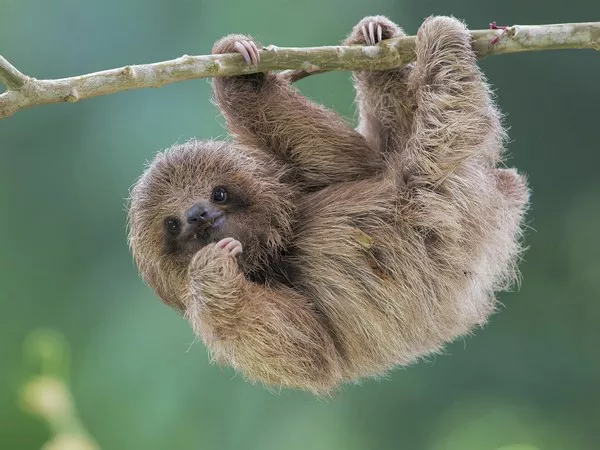In the animal kingdom, speed is often a crucial aspect of survival, allowing prey to evade predators and predators to catch their prey. However, not all animals rely on speed to thrive in their environments. Some have adapted to a slower pace of life, utilizing other strategies to survive and thrive. In this article, we’ll explore the fascinating world of slow animals, highlighting a diverse range of species that have mastered the art of taking it slow.
10 Slow-Moving Animals
1. Sloth (Bradypus spp. and Choloepus spp.):
When it comes to slow animals, sloths are perhaps the most iconic. These arboreal mammals are native to the rainforests of Central and South America, where they spend the majority of their lives hanging upside down from tree branches. Sloths move at an incredibly leisurely pace, with a top speed of just 0.24 kilometers per hour (0.15 miles per hour). Their slow metabolism and low-energy diet of leaves contribute to their sluggish nature.
2. Giant Tortoise (Geochelone nigra):
Found primarily in the Galapagos Islands and the Aldabra Atoll in the Indian Ocean, giant tortoises are renowned for their slow and steady pace. These massive reptiles can weigh up to 400 kilograms (880 pounds) and can live for over a century. Giant tortoises move at a leisurely stroll, using their powerful legs to navigate their habitat and forage for food. Their slow metabolism allows them to survive on sparse vegetation and go for long periods without eating or drinking.
3. Garden Snail (Cornu aspersum):
The garden snail is a common sight in gardens and parks around the world. These terrestrial gastropods move at a glacial pace, with an average speed of just 0.03 kilometers per hour (0.02 miles per hour). Despite their slow movements, garden snails are remarkably efficient at navigating their environment, using their retractable tentacles to sense their surroundings and their muscular foot to propel themselves forward. Their slow pace allows them to conserve energy and avoid predators.
4. Koala (Phascolarctos cinereus):
Koalas are marsupials native to Australia known for their adorable appearance and slow-moving lifestyle. These arboreal mammals spend the majority of their time sleeping or lounging in eucalyptus trees, where they feed on the leaves of their preferred food source. Koalas move slowly and deliberately, conserving energy in their sedentary lifestyle. While they may seem docile, koalas are capable climbers and can move quickly when necessary.
5. Starfish (Asteroidea):
Starfish, also known as sea stars, are fascinating marine creatures known for their radial symmetry and slow movements. These echinoderms move using hundreds of tiny tube feet located on their underside, allowing them to glide along the ocean floor or cling to rocky surfaces. While starfish may not be the fastest swimmers, they are highly efficient predators, using their arms to pry open shellfish and feed on their soft tissues.
6. Manatee (Trichechus spp.):
Manatees, also known as sea cows, are large aquatic mammals found in shallow, slow-moving rivers, estuaries, and coastal waters. These gentle giants move at a leisurely pace, grazing on aquatic vegetation and basking in the sun. Manatees are adapted to a slow-paced lifestyle, with a low metabolic rate and a thick layer of blubber to insulate them from the cold. Despite their slow movements, manatees are graceful swimmers capable of covering long distances.
7. Three-Toed Amphiuma (Amphiuma tridactylum):
The three-toed amphiuma is a species of aquatic salamander found in the southeastern United States. These elongated amphibians have reduced limbs with only three toes, giving them a snake-like appearance. Three-toed amphiumas move slowly and stealthily through the murky waters of swamps and marshes, using their keen sense of smell to locate prey. While they may not be the fastest swimmers, three-toed amphiumas are highly effective predators, feeding on fish, insects, and small amphibians.
8. Star-Nosed Mole (Condylura cristata):
The star-nosed mole is a small, burrowing mammal found in wet lowland areas of eastern North America. These unique creatures have a distinctive star-shaped appendage on their snout, which they use to detect prey in their underground tunnels. While they may not be the fastest diggers, star-nosed moles are incredibly efficient hunters, using their sensitive nose to locate and capture insects, worms, and other small invertebrates.
9. Leaf-Tailed Gecko (Uroplatus spp.):
Leaf-tailed geckos are a group of nocturnal lizards found in the rainforests of Madagascar. These cryptically colored reptiles are masters of camouflage, blending in seamlessly with their leaf litter habitat. Leaf-tailed geckos move slowly and deliberately, using their prehensile tail to anchor themselves to branches and their sticky toe pads to navigate their environment. While they may not be the fastest climbers, leaf-tailed geckos are highly adapted to their arboreal lifestyle.
10. Giant African Land Snail (Achatina fulica):
The giant African land snail is one of the largest terrestrial gastropods in the world, native to East Africa but now found in many tropical and subtropical regions. These slow-moving mollusks have a voracious appetite for a wide range of plant matter, making them a significant agricultural pest in some areas. Despite their sluggish pace, giant African land snails are highly resilient and adaptable, able to thrive in a variety of habitats.
Conclusion:
In the animal kingdom, speed is not always a prerequisite for survival. Slow-moving animals have evolved a variety of strategies to thrive in their environments, from energy-efficient metabolism to stealthy hunting techniques. By exploring the diverse world of slow animals, we gain a deeper appreciation for the remarkable diversity of life on Earth and the incredible adaptations that allow organisms to thrive in even the most challenging conditions.
You Might Be Interested In:

























